Cuvitru 200 Mg/Ml Solution For Subcutaneous Injection
CD
CD
CO
l^~
O
Llj
^Shire
Cuvitru
Package leaflet: Information for the user
Cuvitru 200 mg/ml solution for subcutaneous injection
Human normal immunoglobulin
▼ This medicine is subject to additional monitoring. This will allow quick identification of new safety information. You can help by reporting any side effects you may get. See the end of section 4 for how to report side effects.
Read all of this leaflet carefully before you start using this medicine because it contains important information for you.
- Keep this leaflet. You may need to read it again.
- If you have any further questions, ask your doctor, pharmacist or nurse.
- This medicine has been prescribed for you only. Do not pass it on to others. It may harm them, even if their signs of illness are the same as yours.
- If you get any side effects, talk to your doctor, pharmacist or nurse. This includes any possible side effects not listed in this leaflet. See section 4.
What is in this leaflet
1. What Cuvitru is and what it is used for
2. What you need to know before you use Cuvitru
3. How to use Cuvitru
4. Possible side effects
5. How to store Cuvitru
6. Contents of the pack and other information
1 What Cuvitru is and what it is used for
What Cuvitru is
Cuvitru belongs to a class of medicines called “human normal immunoglobulins”. Immunoglobulins are also known as antibodies and are found in healthy people’s blood. Antibodies are part of the immune system (the body’s natural defences) and help your body to fight infections.
How Cuvitru works
Cuvitru has been prepared from the blood of healthy people. The medicine works in exactly the same way as the immunoglobulins naturally present in the blood.
What Cuvitru is used for
Cuvitru is used in patients with a weak immune system, who do not have enough antibodies in their blood and tend to get frequent infections. Regular and sufficient doses of Cuvitru can raise abnormally low immunoglobulin levels in your blood to normal levels (replacement therapy).
Cuvitru is prescribed to
- patients with inborn lack of antibody production (primary immunodeficiency syndromes).
- patients with a cancer of the blood (chronic lymphocytic leukaemia) that leads to a lack of antibody production and recurrent infections when preventative antibiotics cannot be used.
- patients with cancer of the bone marrow (multiple myeloma) and lack of antibody production with recurrent infections.
- patients with low antibody production following transplantation of bone marrow cells from another person.
2 What you need to know before you use Cuvitru
Do NOT use Cuvitru:
- if you are allergic to immunoglobulins or any of the other ingredients of this medicine (listed in section 6).
- if you have antibodies against immunoglobulin A (IgA) in your blood. This may occur if you have IgA deficiency. Since Cuvitru contains trace amounts of IgA, you might have an allergic reaction.
- into a blood vessel (intravenously) or a muscle (intramuscularly). Warnings and precautions
Talk to your doctor pharmacist or nurse before using Cuvitru.
Allergic reactions
You may be allergic to immunoglobulins without knowing it. Allergic reactions such as sudden fall in blood pressure or anaphylactic shock (a sharp fall in blood pressure with other symptoms such as swelling of the throat, breathing difficulties and skin rash) are rare but they can occasionally occur even if you have not previously had problems with similar treatments. You are at increased risk of allergic reactions if you have IgA deficiency with anti IgA antibodies. Tell your doctor or nurse prior to treatment if you have IgA deficiency. Cuvitru contains residual amounts of IgA which may increase the risk of an allergic reaction. Signs or symptoms of these rare allergic reactions include:
- feeling light headed, dizzy or faint
- skin rash and itchiness, swelling in the mouth or throat, difficulty breathing, wheezing
- abnormal heart rate, chest pain, blueness of lips or fingers and toes
- blurred vision
Your doctor or nurse will first infuse Cuvitru slowly, and carefully monitor you throughout the first infusions so that any allergic reaction can be detected and treated immediately.
► If you notice any of these signs during the infusion, tell your doctor or nurse immediately. He or she will decide whether to slow down the infusion rate or stop the infusion completely.
Monitoring during infusion
Certain side effects may occur more frequently if:
- you are receiving Cuvitru for the first time.
- you have received another immunoglobulin and have been switched to Cuvitru.
- there has been a long interval since you last received Cuvitru.
► In such cases, you will be closely monitored during your first infusion and for the first hour after your infusion has stopped.
In all other cases it is recommended that you are monitored during the infusion and for at least 20 minutes after you receive Cuvitru. Special patient groups
Your doctor will take special care if you are overweight, elderly, diabetic, or if you suffer from high blood pressure, low blood volume (hypovolaemia), or problems with your blood vessels (vascular diseases). In these conditions, immunoglobulins may increase the risk of cardiac infarction, stroke, lung embolism, or deep vein thrombosis, although only in very rare cases.
Your doctor will also take special care if you have or had previously problems with your kidneys, or if you receive medicinal products that may harm your kidney (nephrotoxic medicinal products), as there is a very rare chance of acute kidney failure.
Inflammation of the layers lining the brain (aseptic meningitis, AMS) Infusions of immunoglobulin products may result in inflammation of the layers lining the brain. Discontinuation of immunoglobulin treatment may result in reduction of AMS within several days. The syndrome usually begins within several hours to 2 days following immunoglobulin treatment.
Contact your doctor if you experience the following signs and symptoms: severe headache, neck stiffness, drowsiness, fever, nausea, vomiting and sensitivity to, and discomfort from light, after receiving Cuvitru. Your doctor will decide if further tests are necessary and whether Cuvitru should be continued Destruction of red blood cells (haemolysis)
Cuvitru contains blood group antibodies that may cause destruction of red blood cells and haemolytic anaemia.
Effects on blood tests
Cuvitru contains many different antibodies, some of which can affect blood tests (serological tests).
► Tell your doctor about your treatment with Cuvitru before any blood test.
Home treatment
You and/or your caregiver will be trained to detect early signs of side effects, especially allergic reactions. During the infusion you or your caregiver must look out for first signs of side effects (for further details see section 4, “Possible side effects”).
► If you experience any side effects, you or your caregiver must stop the infusion immediately and contact a doctor.
► If you experience a severe side effect, you or your caregiver must seek emergency treatment immediately.
Information on the source material of Cuvitru Cuvitru is made from human plasma (the liquid part of blood). When medicines are made from human blood or plasma, certain measures are put in place to prevent infections being passed on to patients. These include:
- careful selection of blood and plasma donors to make sure those at risk of carrying infections are excluded, and
- the testing of each donation and pools of plasma for signs of viruses/infections.
- the inclusion of steps in the processing of the blood or plasma that can inactivate or remove viruses.
Despite these measures, when medicines prepared from human blood or plasma are administered, the possibility of passing on infection cannot be totally excluded. This also applies to any unknown or emerging viruses or other types of infections.
The measures taken are considered effective for enveloped viruses such as human immunodeficiency virus (HIV), hepatitis B virus and hepatitis C virus and for the non-enveloped hepatitis A virus and parvovirus B19.
Immunoglobulins have not been associated with hepatitis A or parvovirus B19 infections possibly because the antibodies against these infections, which are contained in Cuvitru, are protective.
It is strongly recommended that every time you use Cuvitru the following data are recorded in your treatment diary:
- the date of administration,
- the batch number of the medicine, and
- the injected volume, flow rate, the number and location of injection sites.
Children and adolescents
The listed warnings and precautions apply both to adults and children.
Other medicines and Cuvitru
Tell your doctor, pharmacist, or nurse if you are taking, have recently taken or might take any other medicines.
Vaccinations
Cuvitru may reduce the effect of some virus vaccines such as measles, rubella, mumps and chicken pox (live virus vaccines). Therefore, after receiving Cuvitru, you may have to wait for up to 3 months before receiving certain vaccines. You may have to wait for up to 1 year after receiving the last dose Cuvitru before you can receive your measles vaccine.
► Please tell your vaccinating doctor or nurse about your treatment with Cuvitru.
Pregnancy, breast-feeding and fertility
If you are pregnant or breast-feeding, think you may be pregnant or are planning to have a baby, ask your doctor or pharmacist for advice before taking this medicine.
No clinical trials have been made with Cuvitru in pregnant or breastfeeding women. But experience with immunoglobulins suggests that there are no harmful effects on the course of pregnancy or the baby to be expected.
If you are breast-feeding and receive Cuvitru, the antibodies of the medicine can also be found in the breast milk and may also protect your baby from certain infections.
Experience with immunoglobulins suggests that no harmful effects on fertility are to be expected.
Driving and using machines
Patients may experience side effects (for example dizziness or nausea) during treatment with Cuvitru that might affect the ability to drive and use machines. If this happens, you should wait until the reactions have disappeared.
3 How to use Cuvitru
Always use this medicine exactly as your doctor has told you. Check with your doctor if you are not sure.
Cuvitru has to be infused under the skin (subcutaneous or SC administration).
Treatment with Cuvitru will be started by your doctor or nurse, but you may be allowed to use the medicine at home once you have received the first few infusions under medical supervision and you (and/or your caregiver) have been adequately trained. You and your doctor will decide if you can use Cuvitru at home. Do not begin treatment with Cuvitru at home until you have received complete instructions.
Dosing
Your doctor will calculate the correct dose for you based on your body weight, any previous treatment you may have received and your response to treatment.
Your doctor will determine whether you need a loading dose (for adults or children) of at least 1.0 to 2.5 ml/kg of body weight divided over several days. Following this, you will be given Cuvitru on a regular basis, from daily to once every two weeks; the cumulative dose per month will be about 1.5 to 5 ml/kg of body weight. Your doctor may adjust your dose depending on your response to the treatment.
Do not change the dose or dosing interval without contacting your doctor. If you think you should receive Cuvitru more or less frequently, please speak to your doctor. If you think you have missed a dose, please speak to your doctor as soon as possible.
Starting treatment
Your treatment will be started by a doctor or nurse experienced in treating patients with a weak immune system and in guiding patients for home treatment. You will be watched carefully throughout the infusion and for at least 1 hour after stopping the infusion to see how well you tolerate the medicine. In the beginning your doctor or nurse will use a slow infusion speed and gradually increase it during the first infusion and in the following infusions. Once the doctor or nurse has found the right dose and speed of infusion for you, you may be allowed to give the treatment to yourself at home.
Home treatment
Cuvitru can be administered by yourself or your caregiver. You will be trained by a doctor or nurse experienced in the guidance and treatment of patients like you. The doctor or nurse will be with you for the first few treatments.
You or your caregiver will be instructed in:
- germ free (aseptic) infusion techniques,
- the use of an administration device (if needed),
- keeping a treatment diary, and
- measures to be taken in case of severe side effects.
You must carefully follow your doctor’s instructions regarding the dose, infusion speed and schedule for infusing Cuvitru so that your treatment works for you.
Method and route of administration
Selection of Infusion Site(s):
Suggested areas for subcutaneous infusion of Cuvitru are abdomen, thighs, upper arms, or lower back. Cuvitru may be infused into multiple infusion sites. Infusion sites should be at least 10 cm apart, Avoid: bony areas, visible blood vessels, scars and any areas of inflammation (irritation) or infection. Rotate sites with each administration as directed by your doctor or nurse.
Multiple subcutaneous infusion sites can be used at the same time by a multi-needle set. The amount of product infused into a single site varies and doses over 30 ml may be divided according to your preference.
Infusion rate:
The recommended initial infusion rate is 10 ml per hour per infusion site. If well tolerated this may be increased at intervals of at least 10 minutes to 20 ml per hour per site for the initial two infusions. For further infusions, the infusion rate may be increased as tolerated.
If you have any further questions on the use of this medicine, please ask your doctor, pharmacist or nurse.
Detailed Instructions for use are provided in the section below:
Do not use Cuvitru at home until you get instructions and training from your doctor or nurse.
Prepare Cuvitru vial(s):
• Remove Cuvitru from the box. In case the product is stored in a refrigerator allow vials to reach room temperature. This may take up to 90 minutes.
• Do not apply heat or place in microwave.
• Do not shake the vial(s).
1. Check the vial(s):
• Do not use beyond expiry date.
• Do not use if the protective cap is missing or broken.
• Look at the color: it should be clear and colorless to pale yellow or light brown.
• Do not use if the solution is cloudy
_or has particles._
2. Gather all supplies
• Gather all supplies:
Items include: vial(s) of Cuvitru, infusion supplies: subcutaneous needle set, transfer device(s), syringe(s), sterile tip caps, sterile clear bandage, tape, gauze, sharps container, infusion pump, infusion log.
• Clean work area.
• Program the infusion pump according to prescribed infusion rates and manufacturer's instructions.
• Wash hands thoroughly and allow to dry.
• Open supplies as shown by your doctor or nurse.
3. Prepare the syringe(s):
• Remove the cap from the vial.
• Wipe each stopper with a sterile alcohol wipe and allow to dry.
• Attach a sterile syringe to a vented spike.
• Insert the vented spike into the center of the vial.
• Turn the vial upside down and pull back on the plunger to pull the solution into the syringe(s).
• Repeat these steps, if using multiple vials to achieve the desired dose.
If using a sterile needle: Attach a sterile syringe to the sterile needle and pull back the plunger of syringe to fill with air which should equal the amount of the solution you will be taking from the vial. Insert the needle into the center of the stopper, and inject air in. Pull back on the plunger to withdraw the desired volume.
4. Prepare the infusion pump and
tubing:
• Use manufacturer directions for filling the tubing and using the pump.
• Attach the syringe filled with solution to the needle set.
• Point the syringe tip up and gently push the plunger of the syringe to remove the air and fill the needle set up to the needle hub.
5. Prepare the infusion site(s):
• Select the number of infusion sites based on the volume of the total dose.
• Choose infusion site(s): upper arms, abdomen, thighs, or lower back
• Avoid: bony areas, visible blood vessels, scars and any areas of inflammation (irritation) or infection.
• Infuse the solution from 1 or multiple infusion sites at the same time.
• Select sites at least 10 cm apart.
• Rotate sites between future infusions.
• Wipe the infusion site(s) with a sterile alcohol wipe beginning at the center of each infusion site and moving outward in circular motion. Allow the infusion site(s) to dry
(at least 30 seconds).

6. Insert and secure the
subcutaneous needle set:
• Remove the needle cover. Firmly grasp and pinch at least 2.5 cm of skin between two fingers.
• Insert needle with a rapid motion straight into the skin at a 90 degree angle. Tape needle in place
with sterile tape (included on transparent dressing).
• If more than one site is used, repeat the steps.
• Check for proper needle placement by pulling back on the syringe plunger to check for blood return in the tubing of the needle set.
• If blood is seen in the tubing, remove and discard the subcutaneous needle and repeat steps 4, 5 and 6 with a new subcutaneous needle and infusion site.
• Secure the needle set in place by applying a sterile protective dressing over the site(s).
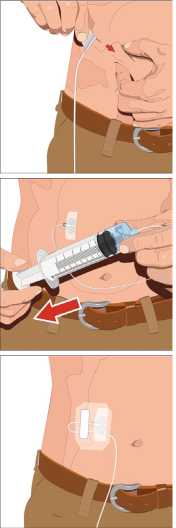

7. Start the infusion
• Follow the manufacturer's instructions to turn pump on and start the infusion
• Check infusion site(s) occasionally
_throughout the infusion._
8. Remove subcutaneous needle(s) from the infusion site(s) when the infusion is complete:
• Remove the needle set by loosening the tape on all edges.
• Pull the needle wings straight up and out.
• Gently press a small piece of gauze over the needle site and cover with a dressing.
• Throw away the needle(s) into the
_sharps container._
9. Record the infusion:
• Remove the peel-off label from the vial(s), which has the product lot number and expiry date, and place the label in your treatment diary/ infusion log.
• Write down the date, time, dose, site(s) of infusion (to assist in rotating sites) and any reactions after each infusion.
• Throw away the disposable supplies, vials, and unused solution as recommended by your doctor or
_nurse._
Use in children and adolescents
The same indications, dose and frequency of infusion as for adults apply for children and adolescents (age 0 to 18).
If you use more Cuvitru than you should
If you think that you used more Cuvitru than you should, speak to your doctor as soon as possible.
If you forget to use Cuvitru
Do not infuse a double dose of Cuvitru to make up for a missed dose. If you think that you have missed a dose speak to your doctor as soon as possible.
4. Possible side effects
Like all medicines, this medicine can cause side effects such as chills, headache, dizziness, fever, vomiting, allergic reactions, feeling sick (nausea), joint pain, low blood pressure and moderate low back pain, although not everybody gets them.
Certain side effects, such as headache, chills, or body aches, may be reduced by slowing the infusion rate.
Serious side effects
Infusions of medicines like Cuvitru can occasionally result in serious, but rare, allergic reactions. You may experience a sudden fall in blood pressure and, in isolated cases, anaphylactic shock. Doctors are aware of these possible side effects and will monitor you during and after the initial infusions.
Tell your doctor or nurse immediately if you notice any of the following:
- feeling light-headed, dizzy or faint,
- skin rash and itchiness, swelling in the mouth or throat, difficulty breathing, wheezing,
- abnormal heart rate, chest pain, blueness of lips or fingers and toes,
- blurred vision
When using Cuvitru at home, you may perform the infusion in the presence of your caregiver who will help you watch out for allergic reactions, stop the infusion, and get help if necessary.
Please also see section 2 of this leaflet about the risk of allergic reactions and using Cuvitru at home.
The following side effects are very common (may affect more than 1 in 10 people):
- headache
- diarrhoea, and nausea
- redness, and pain at the site of infusion
- tiredness
The following side effects are common (may affect more than 1 in 100 pepple):
- dizziness, migraine, and drowsiness
- decreased blood pressure
- abdominal pain
- itching, and rash
- muscular pain
- swelling, itching, rash, and bruising at the site of infusion
- pain
The following side effects are uncommon (may affect more than 1 in 1000 people):
- burning sensation
- abdominal pain lower
- oedema at the site of infusion
- positive blood tests for antibodies
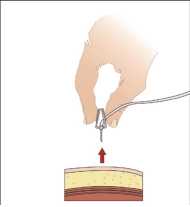
Side effects seen with similar medicines
The following side effects have been observed with infusion of human normal immunoglobulin given under the skin (subcutaneously). Although these side effects have so far not been seen with Cuvitru, it is possible that someone using Cuvitru may get them.
- tingling
- trembling
- fast heart beat
- shortness of breath
- vocal cord dysfunction
- pain in chest
- hardening and/or warmth at the site of infusion Reporting of side effects
If you get any side effects, talk to your doctor, pharmacist or nurse. This includes any possible side effects not listed in this leaflet. You can also report side effects directly via the national reporting system listed below. By reporting side effects you can help provide more information on the safety of this medicine.
United Kingdom
Yellow Card Scheme www.mhra.gov.uk/yellowcard.
Ireland
HPRA Pharmacovigilance Earlsfort Terrace IRL - Dublin 2 Tel: +353 1 6764971 Fax: +353 1 6762517 Website: www.hpra.ie e-mail: medsafety@hpra.ie
5. How to store Cuvitru
Keep this medicine out of the sight and reach of children.
Do not use this medicine after the expiry date which is stated on the label and carton after EXP The expiry date refers to the last day of that month.
Do not use this medicine if you notice that the solution is cloudy, has particles or changed color.
Keep the vials in the outer carton in order to protect from light.
Do not store above 25°C.
Do not freeze.
In case the product is stored in a refrigerator, the unopened vials must be removed from refrigeration and placed at room temperature for a minimum of 90 minutes prior to use. Do not use heating devices including microwaves.
6. Contents of the pack and other information
What Cuvitru contains
- The active substance is human normal immunoglobulin.
- 1ml of Cuvitru contains 200 mg of human protein of which
at least 98% is immunoglobulin G (IgG). The other ingredients are glycine and water for injections.
What Cuvitru looks like and contents of the pack Cuvitru is a solution for injection in vials of 5, 10, 20 or 40 ml. The solution is clear and colourless or pale-yellow or light-brown.
Each vial of 5 ml contains: 1 g of human normal immunoglobulin Each vial of 10 ml contains: 2 g of human normal immunoglobulin Each vial of 20 ml contains: 4 g of human normal immunoglobulin Each vial of 40 ml contains: 8 g of human normal immunoglobulin Not all presentations may be marketed.
Marketing Authorisation Holder
Baxter Innovations GmbH A-1221 Vienna Austria
Manufacturer
Baxalta Belgium Manufacturing SA Boulevard Rene Branquart 80 7860 Lessines Belgium
This leaflet was last revised in
June 2016
LE-07-36116
^Shire
Cuvitru
Package leaflet: Information for the user
Cuvitru 200 mg/ml solution for subcutaneous injection
Human normal immunoglobulin
▼ This medicine is subject to additional monitoring. This will allow quick identification of new safety information. You can help by reporting any side effects you may get. See the end of section 4 for how to report side effects.
Read all of this leaflet carefully before you start using this medicine because it contains important information for you.
- Keep this leaflet. You may need to read it again.
- If you have any further questions, ask your doctor, pharmacist or nurse.
- This medicine has been prescribed for you only. Do not pass it on to others. It may harm them, even if their signs of illness are the same as yours.
- If you get any side effects, talk to your doctor, pharmacist or nurse. This includes any possible side effects not listed in this leaflet. See section 4.
What is in this leaflet
1. What Cuvitru is and what it is used for
2. What you need to know before you use Cuvitru
3. How to use Cuvitru
4. Possible side effects
5. How to store Cuvitru
6. Contents of the pack and other information
1 What Cuvitru is and what it is used for What Cuvitru is
Cuvitru belongs to a class of medicines called “human normal immunoglobulins”. Immunoglobulins are also known as antibodies and are found in healthy people’s blood. Antibodies are part of the immune system (the body’s natural defences) and help your body to fight infections. How Cuvitru works
Cuvitru has been prepared from the blood of healthy people. The medicine works in exactly the same way as the immunoglobulins naturally present in the blood.
What Cuvitru is used for Cuvitru is used in patients with a weak immune system, who do not have enough antibodies in their blood and tend to get frequent infections. Regular and sufficient doses of Cuvitru can raise abnormally low immunoglobulin levels in your blood to normal levels (replacement therapy).
Cuvitru is prescribed to
- patients with inborn lack of antibody production (primary immunodeficiency syndromes).
- patients with a cancer of the blood (chronic lymphocytic leukaemia) that leads to a lack of antibody production and recurrent infections when preventative antibiotics cannot be used.
- patients with cancer of the bone marrow (multiple myeloma) and lack of antibody production with recurrent infections.
- patients with low antibody production following transplantation of bone marrow cells from another person.
2 What you need to know before you use Cuvitru Do NOT use Cuvitru:
- if you are allergic to immunoglobulins or any of the other ingredients of this medicine (listed in section 6).
- if you have antibodies against immunoglobulin A (IgA) in your blood. This may occur if you have IgA deficiency. Since Cuvitru contains trace amounts of IgA, you might have an allergic reaction.
- into a blood vessel (intravenously) or a muscle (intramuscularly).
Warnings and precautions
Talk to your doctor pharmacist or nurse before using Cuvitru.
Allergic reactions
You may be allergic to immunoglobulins without knowing it. Allergic reactions such as sudden fall in blood pressure or anaphylactic shock (a sharp fall in blood pressure with other symptoms such as swelling of the throat, breathing difficulties and skin rash) are rare but they can occasionally occur even if you have not previously had problems with similar treatments. You are at increased risk of allergic reactions if you have IgA deficiency with anti IgA antibodies. Tell your doctor or nurse prior to treatment if you have IgA deficiency. Cuvitru contains residual amounts of IgA which may increase the risk of an allergic reaction. Signs or symptoms of these rare allergic reactions include:
- feeling light headed, dizzy or faint
- skin rash and itchiness, swelling in the mouth or throat, difficulty breathing, wheezing
- abnormal heart rate, chest pain, blueness of lips or fingers and toes
- blurred vision
Your doctor or nurse will first infuse Cuvitru slowly, and carefully monitor you throughout the first infusions so that any allergic reaction can be detected and treated immediately.
► If you notice any of these signs during the infusion, tell your doctor or nurse immediately. He or she will decide whether to slow down the infusion rate or stop the infusion completely.
Monitoring during infusion
Certain side effects may occur more frequently if:
- you are receiving Cuvitru for the first time.
- you have received another immunoglobulin and have been switched to Cuvitru.
- there has been a long interval since you last received Cuvitru.
► In such cases, you will be closely monitored during your first infusion and for the first hour after your infusion has stopped.
In all other cases it is recommended that you are monitored during the infusion and for at least 20 minutes after you receive Cuvitru.
Special patient groups
Your doctor will take special care if you are overweight, elderly, diabetic, or if you suffer from high blood pressure, low blood volume (hypovolaemia), or problems with your blood vessels (vascular diseases). In these conditions, immunoglobulins may increase the risk of cardiac infarction, stroke, lung embolism, or deep vein thrombosis, although only in very rare cases.
Your doctor will also take special care if you have or had previously problems with your kidneys, or if you receive medicinal products that may harm your kidney (nephrotoxic medicinal products), as there is a very rare chance of acute kidney failure.

o
Inflammation of the layers lining the brain (aseptic meningitis. AMS)
Infusions of immunoglobulin products may result in inflammation of the layers lining the brain. Discontinuation of immunoglobulin treatment may result in reduction of AMS within several days. The syndrome usually begins within several hours to 2 days following immunoglobulin treatment. Contact your doctor if you experience the following signs and symptoms: severe headache, neck stiffness, drowsiness, fever, nausea, vomiting and sensitivity to, and discomfort from light, after receiving Cuvitru. Your doctor will decide if further tests are necessary and whether Cuvitru should be continued Destruction of red blood cells (haemolysis)
Cuvitru contains blood group antibodies that may cause destruction of red blood cells and haemolytic anaemia. Effects on blood tests
Cuvitru contains many different antibodies, some of which can affect blood tests (serological tests).
► Tell your doctor about your treatment with Cuvitru before any blood test.
Home treatment
You and/or your caregiver will be trained to detect early signs of side effects, especially allergic reactions. During the infusion you or your caregiver must look out for first signs of side effects (for further details see section 4, “Possible side effects”).
► If you experience any side effects, you or your caregiver must stop the infusion immediately and contact a doctor.
► If you experience a severe side effect, you or your caregiver must seek emergency treatment immediately.
Information on the source material of Cuvitru Cuvitru is made from human plasma (the liquid part of blood). When medicines are made from human blood or plasma, certain measures are put in place to prevent infections being passed on to patients. These include:
- careful selection of blood and plasma donors to make sure those at risk of carrying infections are excluded, and
- the testing of each donation and pools of plasma for signs of viruses/infections.
- the inclusion of steps in the processing of the blood or plasma that can inactivate or remove viruses.
Despite these measures, when medicines prepared from human blood or plasma are administered, the possibility of passing on infection cannot be totally excluded. This also applies to any unknown or emerging viruses or other types of infections.
The measures taken are considered effective for enveloped viruses such as human immunodeficiency virus (HIV), hepatitis B virus and hepatitis C virus and for the non-enveloped hepatitis A virus and parvovirus B19. Immunoglobulins have not been associated with hepatitis A or parvovirus B19 infections possibly because the antibodies against these infections, which are contained in Cuvitru, are protective.
It is strongly recommended that every time you use Cuvitru the following data are recorded in your treatment diary:
- the date of administration,
- the batch number of the medicine, and
- the injected volume, flow rate, the number and location of injection sites.
Children and adolescents
The listed warnings and precautions apply both to adults and children.
Other medicines and Cuvitru
Tell your doctor, pharmacist, or nurse if you are taking, have recently taken or might take any other medicines. Vaccinations
Cuvitru may reduce the effect of some virus vaccines such as measles, rubella, mumps and chicken pox (live virus vaccines). Therefore, after receiving Cuvitru, you may have to wait for up to 3 months before receiving certain vaccines. You may have to wait for up to 1 year after receiving the last dose Cuvitru before you can receive your measles vaccine.
► Please tell your vaccinating doctor or nurse about your treatment with Cuvitru.
Pregnancy, breast-feeding and fertility If you are pregnant or breast-feeding, think you may be pregnant or are planning to have a baby, ask your doctor or pharmacist for advice before taking this medicine.
No clinical trials have been made with Cuvitru in pregnant or breast-feeding women. But experience with immunoglobulins suggests that there are no harmful effects on the course of pregnancy or the baby to be expected.
If you are breast-feeding and receive Cuvitru, the antibodies of the medicine can also be found in the breast milk and may also protect your baby from certain infections.
Experience with immunoglobulins suggests that no harmful effects on fertility are to be expected.
Driving and using machines
Patients may experience side effects (for example
dizziness or nausea) during treatment with Cuvitru that
might affect the ability to drive and use machines. If
this happens, you should wait until the reactions have
disappeared.
3 How to use Cuvitru
Always use this medicine exactly as your doctor has told you. Check with your doctor if you are not sure.
Cuvitru has to be infused under the skin (subcutaneous or SC administration).
Treatment with Cuvitru will be started by your doctor or nurse, but you may be allowed to use the medicine at home once you have received the first few infusions under medical supervision and you (and/or your caregiver) have been adequately trained. You and your doctor will decide if you can use Cuvitru at home. Do not begin treatment with Cuvitru at home until you have received complete instructions.
Dosing
Your doctor will calculate the correct dose for you based on your body weight, any previous treatment you may have received and your response to treatment.
Your doctor will determine whether you need a loading dose (for adults or children) of at least 1.0 to 2.5 ml/kg of body weight divided over several days. Following this, you will be given Cuvitru on a regular basis, from daily to once every two weeks; the cumulative dose per month will be about 1.5 to 5 ml/kg of body weight. Your doctor may adjust your dose depending on your response to the treatment.
Do not change the dose or dosing interval without contacting your doctor. If you think you should receive Cuvitru more or less frequently, please speak to your doctor. If you think you have missed a dose, please speak to your doctor as soon as possible.
Starting treatment
Your treatment will be started by a doctor or nurse experienced in treating patients with a weak immune system and in guiding patients for home treatment. You will be watched carefully throughout the infusion and for at least 1 hour after stopping the infusion to see how well you tolerate the medicine. In the beginning your doctor or nurse will use a slow infusion speed and gradually increase it during the first infusion and in the following infusions. Once the doctor or nurse has found the right dose and speed of infusion for you, you may be allowed to give the treatment to yourself at home.
Home treatment
Cuvitru can be administered by yourself or your caregiver. You will be trained by a doctor or nurse experienced in the guidance and treatment of patients like you. The doctor or nurse will be with you for the first few treatments.
You or your caregiver will be instructed in:
- germ free (aseptic) infusion techniques,
- the use of an administration device (if needed),
- keeping a treatment diary, and
- measures to be taken in case of severe side effects. You must carefully follow your doctor’s instructions regarding the dose, infusion speed and schedule for infusing Cuvitru so that your treatment works for you. Method and route of administration
Selection of Infusion Site(s):
Suggested areas for subcutaneous infusion of Cuvitru are abdomen, thighs, upper arms, or lower back.
Cuvitru may be infused into multiple infusion sites.
Infusion sites should be at least 10 cm apart, Avoid: bony areas, visible blood vessels, scars and any areas of inflammation (irritation) or infection. Rotate sites with each administration as directed by your doctor or nurse. Multiple subcutaneous infusion sites can be used at the same time by a multi-needle set. The amount of product infused into a single site varies and doses over 30 ml may be divided according to your preference.
Infusion rate:
The recommended initial infusion rate is 10 ml per hour per infusion site. If well tolerated this may be increased at intervals of at least 10 minutes to 20 ml per hour per site for the initial two infusions. For further infusions, the infusion rate may be increased as tolerated.
If you have any further questions on the use of this medicine, please ask your doctor, pharmacist or nurse. Detailed Instructions for use are provided in the section below:
Do not use Cuvitru at home until you get instructions and training from your doctor or nurse.
Prepare Cuvitru vial(s):
• Remove Cuvitru from the box. In case the product is stored in a refrigerator allow vials to reach room temperature. This may take up to 90 minutes.
• Do not apply heat or place in microwave.
• Do not shake the vial(s).
1. Check the vial(s):
• Do not use beyond expiry date.
• Do not use if the protective cap is missing or broken.
• Look at the color: it should be clear and colorless to pale yellow or light brown.
• Do not use if the solution is cloudy or has
_particles._
2. Gather all supplies
• Gather all supplies:
Items include: vial(s)
of Cuvitru, infusion supplies: subcutaneous needle set, transfer device(s), syringe(s), sterile tip caps, sterile clear bandage, tape, gauze, sharps container, infusion pump, infusion log.
• Clean work area.
• Program the infusion pump according
to prescribed infusion rates and manufacturer's instructions.
• Wash hands thoroughly and allow to dry.
• Open supplies as shown by your doctor or
_nurse._
3. Prepare the syringe(s):
• Remove the cap from the vial.
• Wipe each stopper with a sterile alcohol wipe and allow to dry.
• Attach a sterile syringe to a vented spike.
• Insert the vented spike into the center of the vial.
• Turn the vial upside down and pull back on the plunger to pull the solution into the syringe(s).
• Repeat these steps, if using multiple vials to achieve the desired dose.
If using a sterile needle:
Attach a sterile syringe to the sterile needle and pull back the plunger of syringe to fill with air which should equal the amount of the solution you will be taking from the vial. Insert the needle into the center of the stopper, and inject air in. Pull back on the plunger to withdraw the desired volume._
4. Prepare the infusion
pump and tubing:
• Use manufacturer directions for filling the tubing and using the pump.
• Attach the syringe filled with solution to the needle set.
• Point the syringe tip up and gently push the plunger of the syringe to remove the air and fill the needle set up to the needle hub.
5. Prepare the infusion
site(s):
• Select the number of infusion sites based on the volume of the total dose.
• Choose infusion site(s): upper arms, abdomen, thighs, or lower back
• Avoid: bony areas, visible blood vessels, scars and any areas of inflammation (irritation) or infection.
• Infuse the solution from 1 or multiple infusion sites at the same time.
• Select sites at least 10 cm apart.
• Rotate sites between future infusions.
• Wipe the infusion site(s) with a sterile alcohol wipe beginning at the center of each infusion site and moving outward in circular motion.
Allow the infusion site(s) to dry (at least 30 seconds).
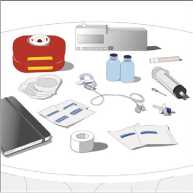
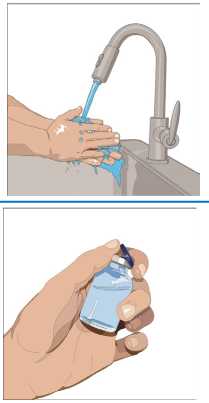

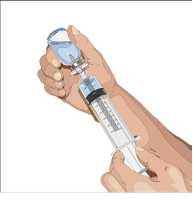
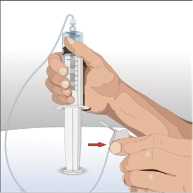

6. Insert and secure the subcutaneous needle set:
• Remove the needle cover. Firmly grasp and pinch at least 2.5 cm of skin between two fingers.
• Insert needle with a rapid motion straight into the skin at a 90 degree angle. Tape needle in place with sterile tape (included on transparent dressing).
• If more than one site is used, repeat the steps.
• Check for proper needle placement by pulling back on the syringe plunger to check for blood return in the tubing of the needle set.
• If blood is seen in the tubing, remove and discard the subcutaneous needle and repeat steps 4,
5 and 6 with a new subcutaneous needle and infusion site.
• Secure the needle set in place by applying a sterile protective dressing over the
_site(s)._
7. Start the infusion
• Follow the manufacturer's instructions to turn pump on and start the infusion
• Check infusion site(s) occasionally throughout
_the infusion._
8. Remove subcutaneous needle(s) from the infusion site(s) when the infusion is complete:
• Remove the needle set by loosening the tape on all edges.
• Pull the needle wings straight up and out.
• Gently press a small piece of gauze over the needle site and cover with a dressing.
• Throw away the needle(s) into the
_sharps container._
9. Record the infusion:
• Remove the peel-off label from the vial(s), which has the product lot number and expiry date, and place the label in your treatment diary/infusion log.
• Write down the date, time, dose, site(s) of infusion (to assist in rotating sites) and any reactions after each infusion.
• Throw away the disposable supplies, vials, and unused solution as recommended by your doctor or nurse.
Use in children and adolescents
The same indications, dose and frequency of infusion as for adults apply for children and adolescents (age 0 to 18). If you use more Cuvitru than you should If you think that you used more Cuvitru than you should, speak to your doctor as soon as possible.
If you forget to use Cuvitru
Do not infuse a double dose of Cuvitru to make up for a missed dose. If you think that you have missed a dose speak to your doctor as soon as possible.

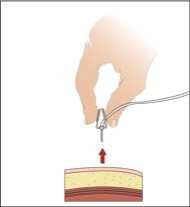
The following side effects are uncommon (may affect more than 1 in 1000 people):
- burning sensation
- abdominal pain lower
- oedema at the site of infusion
- positive blood tests for antibodies Side effects seen with similar medicines
The following side effects have been observed with infusion of human normal immunoglobulin given under the skin (subcutaneously). Although these side effects have so far not been seen with Cuvitru, it is possible that someone using Cuvitru may get them.
- tingling
- trembling
- fast heart beat
- shortness of breath
- vocal cord dysfunction
- pain in chest
- hardening and/or warmth at the site of infusion Reporting of side effects
If you get any side effects, talk to your doctor, pharmacist or nurse. This includes any possible side effects not listed in this leaflet. You can also report side effects directly via the national reporting system listed below. By reporting side effects you can help provide more information on the safety of this medicine.
United Kingdom
Yellow Card Scheme
Ireland
HPRA Pharmacovigilance Earlsfort Terrace IRL - Dublin 2 Tel: +353 1 6764971 Fax: +353 1 6762517 Website: www.hpra.ie e-mail: medsafety@hpra.ie
5. How to store Cuvitru
Keep this medicine out of the sight and reach of children. Do not use this medicine after the expiry date which is stated on the label and carton after EXP The expiry date refers to the last day of that month.
Do not use this medicine if you notice that the solution is cloudy, has particles or changed color.
Keep the vials in the outer carton in order to protect from light.
Do not store above 25°C.
Do not freeze.
In case the product is stored in a refrigerator, the unopened vials must be removed from refrigeration and placed at room temperature for a minimum of 90 minutes prior to use. Do not use heating devices including microwaves.
6. Contents of the pack and other information What Cuvitru contains
- The active substance is human normal immunoglobulin.
- 1ml of Cuvitru contains 200 mg of human protein of which at least 98% is immunoglobulin G (IgG). The other ingredients are glycine and water for injections.
What Cuvitru looks like and contents of the pack
Cuvitru is a solution for injection in vials of 5, 10, 20 or 40 ml. The solution is clear and colourless or pale-yellow or light-brown.
Each vial of 5 ml contains: 1 g of human normal immunoglobulin
Each vial of 10 ml contains: 2 g of human normal immunoglobulin
Each vial of 20 ml contains: 4 g of human normal immunoglobulin
Each vial of 40 ml contains: 8 g of human normal immunoglobulin
Not all presentations may be marketed.
Marketing Authorisation Holder
Baxter Innovations GmbH A-1221 Vienna Austria
Manufacturer
Baxalta Belgium Manufacturing SA Boulevard Rene Branquart 80 7860 Lessines Belgium
This leaflet was last revised in
June 2016
4. Possible side effects
Like all medicines, this medicine can cause side effects such as chills, headache, dizziness, fever, vomiting, allergic reactions, feeling sick (nausea), joint pain, low blood pressure and moderate low back pain, although not everybody gets them.
Certain side effects, such as headache, chills, or body aches, may be reduced by slowing the infusion rate. Serious side effects
Infusions of medicines like Cuvitru can occasionally result in serious, but rare, allergic reactions. You may experience a sudden fall in blood pressure and, in isolated cases, anaphylactic shock. Doctors are aware of these possible side effects and will monitor you during and after the initial infusions.
Tell your doctor or nurse immediately if you notice any of the following:
- feeling light-headed, dizzy or faint,
- skin rash and itchiness, swelling in the mouth or throat, difficulty breathing, wheezing,
- abnormal heart rate, chest pain, blueness of lips or fingers and toes,
- blurred vision
When using Cuvitru at home, you may perform the infusion in the presence of your caregiver who will help you watch out for allergic reactions, stop the infusion, and get help if necessary.
Please also see section 2 of this leaflet about the risk of allergic reactions and using Cuvitru at home.
The following side effects are very common (may affect more than 1 in 10 people):
- headache
- diarrhoea, and nausea
- redness, and pain at the site of infusion
- tiredness
The following side effects are common (may affect more than 1 in 100 people):
- dizziness, migraine, and drowsiness
- decreased blood pressure
- abdominal pain
- itching, and rash
- muscular pain
- swelling, itching, rash, and bruising at the site of infusion
- pain
LE-07-36117